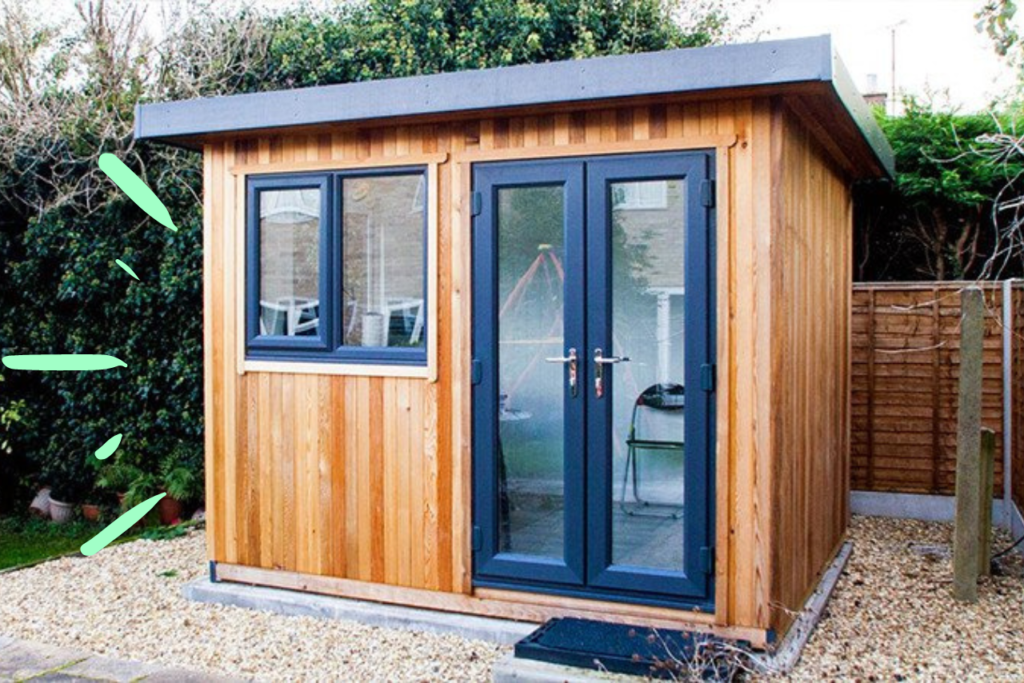As the pandemic forced millions of Britons to work remotely, many found themselves scrambling to set up home offices in unlikely spaces – from dining room tables to closets, and even garden sheds.
Indeed, the trend of repurposing garden sheds as home offices has become increasingly popular in recent years, with people seeking out creative solutions to cope with the challenges of remote work, even as the pandemic (fingers crossed) disappears into the rearview mirror.
Hell, the concept has even garnered its very own affectionate nickname – the ‘shoffice’ – and you just know that when a new portmanteau has entered the popular lexicon (and articles like these proliferate), that the practice has well and truly gone mainstream.
But, as with any DIY project, there are bound to be challenges along the way, and this has never been truer than when the garden shed and the home office meet, with the threat of damp, distraction and even death (yep; death) ever-present. With that in mind, today we’re exploring 10 issues you will likely encounter when repurposing your garden shed into a home office, and the IDEAL ways to fix them.
Insufficient Space
A common issue faced during the conversion of a garden shed into a home office is the distinct lack of space. Garden sheds are often compact, which can make it difficult to accommodate all the necessary furniture and equipment for a comfortable and productive working environment.

To maximise the available space, opt for multi-functional furniture pieces, such as a desk with built-in storage or a fold-out wall-mounted table. The following shoffice based storage solutions will help keep the floor area clutter-free:
- Wall-mounted shelves: Garden sheds are typically limited on space, so using wall-mounted shelves can provide much-needed storage without taking up valuable floor space. Consider using sturdy brackets and adjustable shelves to accommodate items of varying sizes.
- Vertical storage solutions: Vertical storage is an excellent way to increase storage capacity while still keeping the shed space open and inviting. Install an adjustable metal shelving unit to hold office supplies, books, and other items.
- Built-in cabinetry: Built-in cabinets are an excellent way to add storage space while maintaining a clean and uncluttered aesthetic. Consider choosing cabinets with doors or drawers and adjustable shelving to best suit your storage needs.
- Pegboard: Pegboards are versatile storage solutions that can be customised to hold a variety of items, from tools to office supplies. Install a pegboard on an empty wall to organise items and make them easily accessible.
- Rolling storage carts: Rolling storage carts are perfect for the shoffice as they can be moved around the shed to accommodate your needs. Consider using a rolling cart to hold your printer, scanner, and other office accessories.
Read: 7 creative ways to squeeze a home office into an already crowded living space
Poor Insulation
Garden sheds are typically not designed for year-round use (and certainly aren’t designed for daily occupation by, you know, a human) and may lack proper insulation. This can result in an uncomfortable working environment during more inclement weather conditions.
Proper insulation will help maintain a consistent temperature within the office, improving comfort and energy efficiency. Here’s how to insulate your shed to make it office ready:
- Assess the shed: Before insulating your garden shed for human habitation, assess the overall condition of the shed. Check for any signs of damage, rot, or water leaks.
- Choose the right insulation material: Select the insulation material that is best suited for your garden shed. For example, fibreglass is a popular choice, but spray foam insulation may be a better option if you have irregular-shaped walls or ceilings.
- Insulate the walls and ceiling: Cover the walls and ceiling with insulation material to prevent heat loss and maintain a comfortable temperature inside the shed.
- Insulate the floor: If your garden shed has a wooden floor, you can insulate it by using rigid foam insulation or fibreglass batts. This will help to keep the shed warm and prevent moisture from seeping in.
- Install weatherstripping: To reduce air leaks, install weatherstripping around the door and windows of your garden shed.
- Seal any gaps or cracks: Look for any gaps or cracks in the shed’s walls or ceiling and seal them with caulk or expanding foam.
- Add ventilation: Ensure that the garden shed has proper ventilation to prevent moisture buildup, which can lead to mould growth.
- Seek professional advice: If you are uncertain about how to insulate your garden shed, it may be best to seek professional advice. They can provide you with specific tips and recommendations on how to insulate your shed for human habitation safely.
Inadequate Lighting
Limited natural light and insufficient artificial lighting can make a garden shed feel dark and cramped, negatively impacting productivity.
To encourage the flow of more natural light in your shoffice, consider the following:
- Install a skylight or roof windows: One of the best ways to bring natural light into a shed home office is to install a skylight or roof windows. This allows natural light to pour into the space without taking up any floor space, potentially improving your productivity within it!
- Make use of reflective surfaces: You can also increase the natural light in your shed office by using reflective surfaces like mirrors, stainless steel or light-coloured walls. By reflecting light, you can create the illusion of a brighter and more spacious room.
- Use transparent doors: Installing transparent or glass doors in your shed office can also help to increase the amount of natural light that enters the room. This allows light to flow through the space without hindrance, making it feel brighter and more welcoming.
- Trim trees and shrubs: If your shed office is surrounded by trees and shrubs, it may be blocking the natural light from entering the space. By trimming these plants back, you can allow more sunlight to enter the room.
- Choose light window treatments: When selecting window treatments for your shed office, opt for light, translucent fabrics that allow natural light to filter through. This will help to maximise the amount of natural light that enters the space while still providing some privacy.

Lack Of Electrical Outlets
Garden sheds may not have an adequate number of electrical outlets to support the various devices and equipment required for a home office.
Consult a licensed electrician to install additional outlets and ensure that the shed’s electrical system can handle the increased load – this isn’t a job that you’ll want to do yourself. Alternatively, consider using power strips with surge protectors to safely connect multiple devices to a single outlet.
Read: 8 interesting ideas for repurposing your garden room into a wellness space
Noise Distractions
The proximity of a garden shed to outdoor noise, such as traffic or neighbours, can create a distracting work environment.
The first thing you need to do is to seal any air gaps in the walls, doors, and windows. Use weather stripping or caulk to plug these gaps, and you can also add a door sweep to the bottom of the door to reduce noise from entering. Doing this will prevent external noise from seeping into your workspace.
Next, consider insulating your shed walls if they’re not already insulated. Insulation helps to absorb sound waves and reduces the amount of noise that enters or escapes from the shed. You can use fibreglass batts or spray foam insulation to cover the walls, ceiling, and floor.
Another option is to install soundproof curtains, which can help to absorb sound and block out noise from the outside. These curtains are made with sound absorbing materials and are a great alternative to traditional curtains. You can also use acoustic panels, which are designed to absorb sound and reduce echoes in a room.
Finally, if you’re still struggling with noise pollution, consider installing a white noise machine or a sound masking system. These devices produce a consistent background noise that can help mask unwanted sounds and provide a more peaceful working environment.
Aesthetic Considerations
A garden shed may not initially have the aesthetic appeal desired for a home office, but this is easily remedied by personalising the space by painting the interior walls, adding window treatments, and incorporating decorative elements that reflect individual style preferences. Choose ergonomic and visually appealing furniture to create a comfortable and inspiring work environment.
For a seamless blend of style and resilience, the timber garden offices from Garden Affairs provide an excellent foundation, offering pre-designed and customisable options to suit your needs.
Limited Internet Connectivity
A garden shed may be located too far from the main house to receive a strong Wi-Fi signal, resulting in slow or unreliable internet connectivity.
Install a Wi-Fi extender or mesh network system to boost the Wi-Fi signal strength within the shed. The latter uses multiple access points that communicate with each other to create a blanket of Wi-Fi coverage, and can be a particularly good solution for larger gardens or areas with multiple structures.
Alternatively, consider powerline adapters, which use your home’s existing electrical wiring to transmit data, allowing you to extend your network to areas that are hard to reach with Wi-Fi.
If all else fails, consider running an Ethernet cable from your router to the shed. This will provide a fast and reliable connection.

Temperature Control
One of the most challenging aspects of converting a garden shed into a home office is maintaining a comfortable working temperature throughout the year. Garden sheds can become uncomfortably hot during summer months and extremely cold during winter (particularly pertinent right now, as the UK freezes), making it difficult to maintain a productive work environment.
To address temperature control issues in your shoffice, consider these solutions:
- Install a mini-split system: A ductless mini-split air conditioning and heating system can provide year-round temperature control without requiring extensive modifications to the shed structure. These systems are energy-efficient and can be controlled remotely.
- Add window treatments: Install thermal blinds or cellular shades to help regulate temperature. These can block out excessive heat during summer and provide an extra layer of insulation during winter.
- Use portable solutions: For a more budget-friendly approach, consider using portable heaters during winter months and mobile air conditioning units or high-powered fans during summer. Just be sure to choose models with appropriate safety features and ensure your electrical system can handle the additional load.
- Consider external shade: Plant deciduous trees or install exterior awnings to provide natural shade during hot summer months while allowing beneficial solar gain during winter when leaves have fallen.
- Monitor humidity levels: Install a smart thermometer that tracks both temperature and humidity levels, allowing you to adjust your climate control solutions accordingly and maintain optimal working conditions throughout the year.
This temperature management system will help ensure your shoffice remains a comfortable workspace regardless of the season, ultimately contributing to better productivity and work satisfaction.
Security Concerns
Converting a garden shed into a home office may raise security concerns, particularly if expensive equipment or sensitive documents are stored within the space.
Implement security measures such as installing sturdy locks on doors and windows, incorporating motion-sensor lighting, and utilising a security camera system. Additionally, ensure that valuable items are stored securely when not in use.
Poor Ventilation
Inadequate ventilation in a garden shed can lead to poor air quality and increased humidity, potentially causing discomfort and damage to electronic equipment.
There are several ways to improve ventilation in a garden shed that’s being used as a home office:
- Install vents: Adding vents to the shed will allow fresh air to flow in and stale air to escape. The number and size of vents will depend on the size of the shed and the ventilation needs.
- Use a dehumidifier: If the shed is damp, a dehumidifier can help reduce the moisture in the air, making it easier to breathe and preventing mould growth.
- Add a fan: Installing a fan will help circulate the air and keep it fresh. A ceiling fan or a portable fan can be used for this purpose.
- Use natural ventilation: If the shed has windows, they can be opened to allow fresh air to flow in. When weather permits, opening windows and doors will allow fresh air to flow freely throughout the shed.
The Bottom Line
Repurposing a garden shed into a home office can be a rewarding project that provides a dedicated workspace away from the distractions of the main house. By addressing these nine potential issues, homeowners can create a functional, comfortable, and stylish home office that meets their unique needs and preferences.




